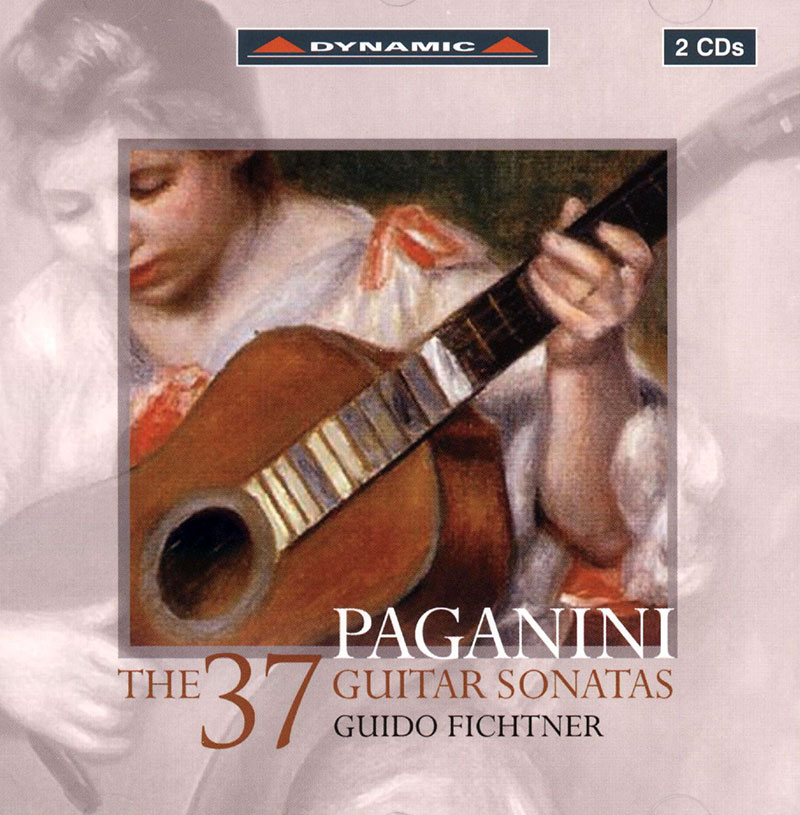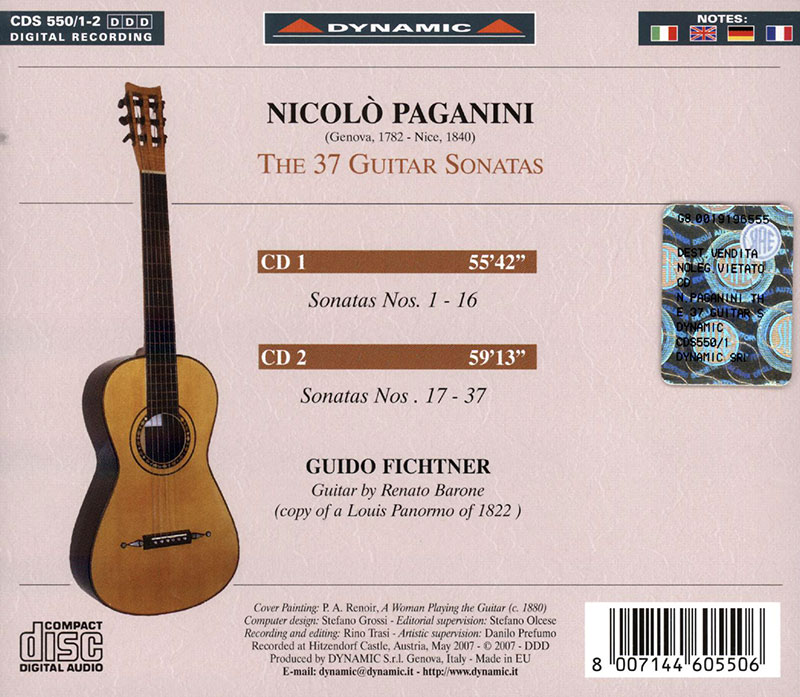Logowanie
Mikołaj - ten to ma gest!
Miles Davis, Horace Silver, Jay Jay Johnson, Percy Heath, Kenny Clarke, Lucky Thompson
Walkin'
20bit K2Super Coding - ale jak to brzmi!
Kasety magnetofonowe
Winylowy niezbędnik
ClearAudio
Double Matrix Professional - Sonic
najbardziej inteligentna i skuteczna pralka do płyt winylowych wszelkiego typu - całkowicie automatyczna
PAGANINI, Guido Fichtner
The 37 Guitar Sonatas

- Disc: 1
- 1. Sonata for guitar No. 1 in A major, MS 84/1: Minuetto
- 2. Sonata for guitar No. 1 in A major, MS 84/1: Andantino
- 3. Sonata for guitar No. 2 in A major, MS 84/2: Minuetto
- 4. Sonata for guitar No. 2 in A major, MS 84/2: Allegretto ossia Rondoncino
- 5. Sonata for guitar No. 3 in C major, MS 84/3: Minuetto
- 6. Sonata for guitar No. 3 in C major, MS 84/3: Valtz
- 7. Sonata for guitar No. 4 in D major, MS 84/4: Minuetto
- 8. Sonata for guitar No. 4 in D major, MS 84/4: Rondoncino
- 9. Sonata for guitar No. 5 in G major, MS 84/5: Minuetto
- 10. Sonata for guitar No. 5 in G major, MS 84/5: Andantino
- 11. Sonata for guitar No. 6 in F major, MS 84/6: Minuetto
- 12. Sonata for guitar No. 6 in F major, MS 84/6: Allegretto
- 13. Sonata for guitar No. 7 in F major, MS 84/7: Minuetto
- 14. Sonata for guitar No. 7 in F major, MS 84/7: Valtz
- 15. Sonata for guitar No. 8 in G major, MS 84/8: Minuetto
- 16. Sonata for guitar No. 8 in G major, MS 84/8: Allegretto scherzando
- 17. Sonata for guitar No. 9 in C major, MS 84/9: Minuetto
- 18. Sonata for guitar No. 9 in C major, MS 84/9: Valtz
- 19. Sonata for guitar No. 10 in D major, MS 84/10: Minuetto
- 20. Sonata for guitar No. 10 in D major, MS 84/10: Valtz
- 21. Sonata for guitar No. 11 in A major, MS 84/11
- 22. Sonata for guitar No. 12 in A major, MS 84/12: Minuetto
- 23. Sonata for guitar No. 12 in A major, MS 84/12: Allegretto
- 24. Sonata for guitar No. 13 in C major, MS 84/13: Minuetto
- 25. Sonata for guitar No. 13 in C major, MS 84/13: Andantino
- 26. Sonata for guitar No. 14 in F major, MS 84/14: Minuetto , Valtz
- 27. Sonata for guitar No. 14 in F major, MS 84/14: Allegretto
- 28. Sonata for guitar No. 15 in C major, MS 84/15: Minuetto, Perligordino
- 29. Sonata for guitar No. 15 in C major, MS 84/15: Allegretto
- 30. Sonata for guitar No. 16 in E major, MS 84/16: Minuetto
- 31. Sonata for guitar No. 16 in E major, MS 84/16: Allegretto
- Disc: 2
- 1. Sonata for guitar No. 17 in A major, MS 84/17: Minuetto
- 2. Sonata for guitar No. 17 in A major, MS 84/17: Perligordino
- 3. Sonata for guitar No. 18 in A major, MS 84/18: Minuetto
- 4. Sonata for guitar No. 18 in A major, MS 84/18: Allegretto
- 5. Sonata for guitar No. 19 in C major, MS 84/19: Minuetto
- 6. Sonata for guitar No. 19 in C major, MS 84/19: Allegretto
- 7. Sonata for guitar No. 20 in C major, MS 84/20: Minuetto
- 8. Sonata for guitar No. 20 in C major, MS 84/20: Valtz
- 9. Sonata for guitar No. 21 in A major, MS 84/21: Minuetto
- 10. Sonata for guitar No. 21 in A major, MS 84/21: Valtz
- 11. Sonata for guitar No. 22 in D major, MS 84/22: Minuetto
- 12. Sonata for guitar No. 22 in D major, MS 84/22: Andantino
- 13. Sonata for guitar No. 23 in A major, MS 84/23: Minuetto detto il Matto
- 14. Sonata for guitar No. 23 in A major, MS 84/23: Allegretto
- 15. Sonata for guitar No. 23 in A major, MS 84/23: Allegretto
- 16. Sonata for guitar No. 24 in G major, MS 84/24: Minuetto
- 17. Sonata for guitar No. 24 in G major, MS 84/24: Andantino
- 18. Sonata for guitar No. 25 in E major, MS 84/25: Minuetto
- 19. Sonata for guitar No. 25 in E major, MS 84/25: Valtz
- 20. Sonata for guitar No. 26 in A major, MS 84/26: Minuetto per la Signora Marina
- 21. Sonata for guitar No. 26 in A major, MS 84/26: Allegretto
- 22. Sonata for guitar No. 27 in A major, MS 84/27: Minuetto per la Signora Marina
- 23. Sonata for guitar No. 27 in A major, MS 84/27: Valtz
- 24. Sonata for guitar No. 28 in G major, MS 84/28: Minuetto
- 25. Sonata for guitar No. 28 in G major, MS 84/28: Andantino Amorosa
- 26. Sonata for guitar No. 29 in G major, MS 84/29: Minuetto
- 27. Sonata for guitar No. 29 in G major, MS 84/29: Andantino
- 28. Sonata for guitar No. 30 in A major, MS 84/30: Minuetto
- 29. Sonata for guitar No. 30 in A major, MS 84/30: Allegro
- 30. Sonata for guitar No. 31 in C major, MS 84/31: Minuetto
- 31. Sonata for guitar No. 31 in C major, MS 84/31: Rondoncino, Valtz
- 32. Sonata for guitar No. 32 in E major, MS 84/32: Minuetto
- 33. Sonata for guitar No. 32 in E major, MS 84/32: Valtz
- 34. Sonata for guitar No. 33 in C minor, MS 84/33: Minuetto
- 35. Sonata for guitar No. 33 in C minor, MS 84/33: Andantino
- 36. Sonata for guitar No. 34 in A major, MS 84/34
- 37. Sonata for guitar No. 35 in E major, MS 84/35
- 38. Sonata for guitar No. 36 in A major, MS 84/36
- 39. Sonata for guitar No. 37 in A major, MS 84/37
- Guido Fichtner - guitar
- PAGANINI
guitar of Renato Barone, copy of the Louis Panormo dated 1822
As well as being an indispensabile instrument for accompanying violin sonatas, trios and quartets, the guitar was often used by Paganini as a solo instrument, especially during the years of his youth. All Paganini's guitar compositions are written for "chittarra [sic] francese", as the musician frequently defined it, that is the guitar with six simple strings. In the last decade of the eighteenth century this new type of guitar had definitively replaced the old five-string model, also known as the "Spanish guitar". The 37 Sonatas M.S. 84 are mostly two-movement compositions (only the eleventh and the last four are single-movement works), on the model of the sonatas for violin and guitar. The one thing that is missing, compared to these sonatas, is a genuine slow movement. The first movement is always a Minuetto in 3/4 time, and is often of virtuoso character, whilst the second may be an Allegretto, a Valtz, a Rondoncino, etc. This recording was made using a copy of the Panormo guitar of 1822 built by the Renato Barone. In the ritornelli, Guido Fichtner has added occasional little variations and embellishments to Paganini's score, offering a reading that is highly virtuoso, brilliant and full of imagination to these original, important examples of the history of the guitar in the nineteenth century.































